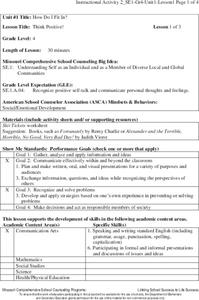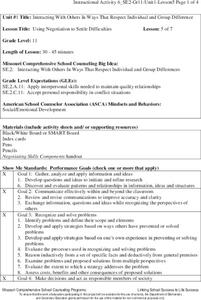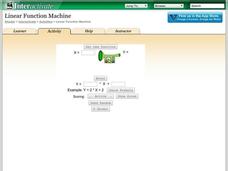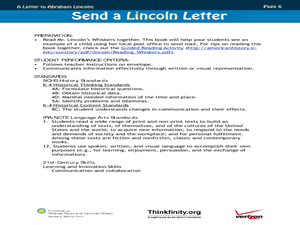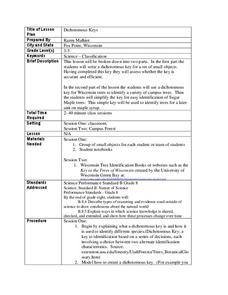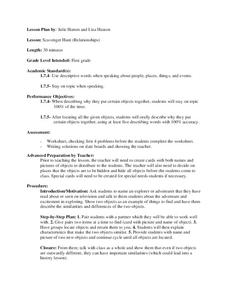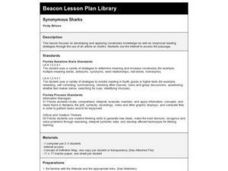Missouri Department of Elementary
I’m A Star!
A lesson encourages scholars to be star community members. Pupils take part in a class discussion that challenges them to brainstorm at least two ways to show responsibility within one's community. Small groups play a game in which...
Missouri Department of Elementary
Think Positive!
Following an attention-grabbing read-aloud, scholars brainstorm ways they can change negative thoughts into positive thoughts. Small groups plan and perform a skit that showcases one of the new ideas to uplift one's feelings....
Missouri Department of Elementary
I’m Thumbody!
Positive and negative thinking is the focus of a lesson that boost self-awareness. Beginning with a whole-class discussion, scholars brainstorm what positive thinking looks and sounds like then compares and contrast the two types of...
Missouri Department of Elementary
What Does Respect Look Like at Home?
Individuals consider why is it important to respect family members as they complete a self-respect survey to assess their respectful behaviors at home. They then choose three items from the survey and write about how they plan to improve...
Missouri Department of Elementary
To Give In or Not to Give In—That Is the Question!
No! A very simple word that can be very hard to say. Seventh graders have an opportunity to practice this difficult skill as they engage in a series of role-playing scenarios. As an exit ticket, 7th graders write a reflection on the...
Missouri Department of Elementary
Managing Conflicts
Conflicts happen. Learning how to manage conflicts in mature and positive ways is an important part of social-emotion growth. The lesson offers insight into behaviors that exacerbate conflicts as well as suggestions for how to resolve...
Missouri Department of Elementary
Using Negotiation to Settle Difficulties
Negotiating can be a win/win experience if the involved parties apply the skills and techniques offered in a lesson about negotiating to settle differences.
California Academy of Science
Buoyancy Bulls-Eye
Why does a seastar sink, but a jellyfish float? Through a fun investigation, learners examine the concept of buoyancy using simple household items. The challenge: create neutral buoyancy for an action figure in water. With ample...
PBS
What Are the Primaries and Caucuses?
What are the essential differences between primaries and caucuses? As part of a study of the process by which Americans select their candidates for US president, class members examine the nominating process, the changes that have...
New South Wales Department of Education
Invertebrates
Of all invertebrates, insects by far are the most numerous. Scholars discuss invertebrates and then use a key to classify them. They see different examples and must describe features of each organism based upon the key.
Polar Trec
Animal Monitoring Introduction
Not only do mealworms taste great, they are also great for classroom science lessons. In pairs, young scientists observe and record what they see as they check out what their mealworms are doing from minute to minute. Each minute...
Shodor Education Foundation
Linear Function Machine
What goes in must come out! Learners play with a function machine to determine the correct function. They enter input values and watch as the machine produces the output.
Curated OER
Send Lincoln a Letter
Students discover the postal service through a letter writing activity. In this U.S. Government lesson, students read the book Mr. Lincoln's Whiskers, and discover the life history of President Abraham Lincoln. Students write...
Curated OER
Interactive Question Asker
Learners practice studying chapters from a unit by creating an electric circuit. In this electronic studying lesson, students utilize a file folder, hole punch, foil, light bulb and battery to create a wired circuit behind answers...
Curated OER
Animal Diaries
Students read Diary of a Worm by Foreen Cronin. In this journal writing lesson plan, students research an animal and write a diary by their animal. Students apply the research they've completed in their writings. Students share their...
Curated OER
Global Warming and Climate Change
Students explore the environment by writing a persuasive letter. In this global warming lesson, students identify the key problems with our energy consumption in the United States. Students complete worksheets and write a letter...
Curated OER
Who? What? Where? When? - Story Elements
Second graders see how to identify and describe character, setting, and plot in various stories from picture books and story videos. They use picture books and story videos to practice identifying and describing the story elements.
Curated OER
Designing a Web Page
Students utilize educational software to create their own websites. In this web design lesson, students collaborate in groups to create web page designs based on workers and figures from their community. Students research...
Curated OER
Dichotomous Keys
Students utilize dichotomous keys to identify trees in their schools. In this ecological identification lesson plan, students practice creating dichotomous keys based on simple subjects such as hair color or sex of a person....
Curated OER
Stiochiometry: Quantifying Changes in the Environment
Young scholars examine stoichiometry. In this chemical reaction and mole lesson, students complete an experiment based on readiness levels to explore that changes are quantified in chemical reactions.
Curated OER
Scavenger Hunt
First graders participate in a scavenger hunt. In this grouping lesson, 1st graders search for pictures of objects around the room, then find the card with the name of that object written on it. Students also discuss the similiarities...
Curated OER
Money Matters
Students practice spending money by completing math word sentences. In this economics lesson, students utilize problem solving strategies to complete word problems written on the board involving making purchases with money....
Curated OER
Synonymous Sharks
Students locate and read an Internet article on sharks. They write a summary of the article, and complete a Concept of Definition Map using information from the article.
Curated OER
Understanding The Preamble
Students explore the Preamble of the U.S. Constitution. In this government lesson, students write a preamble to encourage cooperation in their classroom as they study the Preamble of the U.S. Constitution.

